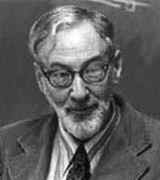Person: Koopmans, Tjalling Charles

Tjalling Charles Koopmans was a Dutch American mathematician and economist. He won the Nobel prize in Economics for his work on the theory of the optimum allocation of resources.
Mathematical Profile (Excerpt):
- His parents, Sjoerd Koopmans and Wijtske van der Zee, were both school teachers who held education in the highest regard.
- Home life was happy with much music making (Tjalling was taught to play the violin) and frequent religious instruction.
- When he was twelve years old, Tjalling was sent to the Christian High School at Hilversum which was about 15 km from his home.
- At age fourteen Tjalling was awarded a stipend by the St Geertruidsleen of Wijmbritseradeel which supported him during his remaining three years at the Christian High School and it also supported him at the University of Utrecht, which he entered in 1927.
- Koopmans graduated with the equivalent of a Master's degree in 1932.
- After his studies at Utrecht, Koopmans studied under Jan Tinbergen in Amsterdam during 1934 and then under Ragnar Frisch in Oslo in 1935.
- Koopmans was appointed as a lecturer at the Netherlands School of Economics, Rotterdam, in 1936 where he spent a couple of years as a colleague of Tinbergen before moving to the League of Nations in Geneva.
- The first discovery was by L V Kantorovich, a Soviet citizen, the second was by T C Koopmans, Dutch, and the third by G B Dantzig, American.
- Koopmans joined the Cowles Commission for Research in Economics at the University of Chicago in 1944.
- Let us briefly mention some of Koopmans' papers.
- Koopmans, who lived in Hamden, Connecticut, died at Yale-New Haven Hospital after suffering a series of cerebral strokes.
Born 28 August 1910, 'sGraveland, Netherlands. Died 26 February 1985, New Haven Connecticut, USA.
View full biography at MacTutor
Tags relevant for this person:
Origin Netherlands, Prize Nobel
Thank you to the contributors under CC BY-SA 4.0! 

- Github:
-

- non-Github:
- @J-J-O'Connor
- @E-F-Robertson
References
Adapted from other CC BY-SA 4.0 Sources:
- O’Connor, John J; Robertson, Edmund F: MacTutor History of Mathematics Archive
